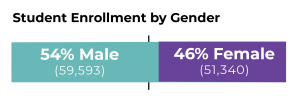CAREER AND TECHNICAL EDUCATION
Student-Centered, Inclusive Access to Successful Careers
Like many of the European models it draws from, the Blueprint for Maryland’s Future puts stock in the proven efficiency and successful outcomes of well-funded and expanded career and technical training programs. Now, a long-overdue expansion to local career and technical education (CTE) gives more students greater opportunity to learn about an industry, get job-ready skills, and obtain a certificate or credential to start work upon graduation or continue their training and/or academic education at a two or four-year school.
This shift to a more student-centered, inclusive, and respectful school culture acknowledges the many and varied talents students bring to school. This shift creates more engagement, better attendance, more confidence, and higher graduation rates especially for students living in areas of concentrated poverty. According to the Association for Career & Technical Education, taking just one CTE class for every two academic classes minimizes the risk of students dropping out of high school. These opportunities create new pathways for students, helping to mitigate the effects of economic segregation and social, racial, and economic injustice in urban and rural communities. With a commitment to CTE, the Blueprint once again underlines its focus on equity.
CTE is included in the Blueprint’s College and Career Readiness (CCR) Pathways, which mandate an internationally benchmarked curriculum, including regularly exposing students in the early grades to meaningful and well-paying careers and career counseling. This curriculum will allow most students to attain college- and career-ready status at the end of 10th grade when they choose an IB, AP, or Cambridge diploma program, early college, and/or a rigorous technical education pathway that leads to industry-recognized credentials and high-paying jobs.
Starting in the 2023-2024 school year, all eligible 11th and 12th grade students who meet the CCR standards must have free access to these programs—college prep, quality CTE, and expanded dual enrollment (high school and post-secondary enrollment) that includes non-credit courses leading to a certificate or license. For CTE students, this also includes apprenticeships that lead to an industry-recognized credential or postsecondary certificate. Apprenticeship Maryland—Maryland’s growing apprenticeship program—includes 20 of the state’s 24 school systems, with only Cecil, Garrett, Somerset, and Worcester counties not yet signed on. Skills USA, a national organization with many participating schools and programs in Maryland, supports CTE educators and students in setting skill standards for programs through partnerships of students, teachers, and industry.
This new CTE programming is no longer under the sole purview of MSDE. That shifts to the Blueprint’s Accountability and Implementation Board (AIB) and the new Career and Technical Education Committee. The committee must “build an integrated, globally competitive framework for providing CTE to Maryland students in public schools, institutions of postsecondary education, and the workforce,” and:
- Ensure that CTE programs are aligned with the state’s economic development and workforce goals and operate with best global practices;
- Set content qualification and recruitment standards for CTE instructors; and
- Determine which programs should be approved for credit towards high school graduation requirements.
The state-level CTE Committee will set county board goals and supervise a CTE Expert Review Team Program (the Blueprint’s built-in review board for each of the Blueprint areas) for schools’ CTE programs. At the local level, county boards of education will approve CTE programs that are not only consistent with the state committee guidelines but also aligned with the workforce needs of the community.
CTE Programs of Study: High School through Community College
State Program of Study
Programs of study developed by the state in collaboration with business representatives aligned to Maryland’s 11 career clusters (see sidebar, page 1).
Local Program of Study
Programs of study developed by local school systems in coordination with local advisory councils and other stakeholders to address local/regional workforce needs aligned to Maryland’s 11 career clusters.
Postsecondary Program of Study
Programs of study developed by community colleges in coordination with advisory councils and other stakeholders to address local and regional workforce needs aligned to Maryland’s 11 career clusters.
P-TECH Program
Pathways in Technology Early College High (P-TECH) Schools are innovative grade 9 to 14 public schools that create clear pathways from high school to college and career for young people from all academic backgrounds. In six years or less, students graduate with a high school diploma and a no-cost, two-year associate degree.
2020 Grade 9–12 CTE Enrollment in Maryland Public Schools
The Blueprint’s goal is to prepare students for a diverse, modern economy. It sets a target that by school year 2029-2030, 45% of graduating public school students will achieve an industry-recognized occupational credential before they graduate.
In Maryland, there are currently 46 MSDE-approved high school CTE programs in 11 career clusters in a total of 259 schools.


- Arts, Media, and Communications
- Business Management and Finance
- Career and Research Development
- Construction and Development
- Consumer Service, Hospitality, and Tourism
- Environmental, Agriculture, and Natural Resources
- Health and Biosciences
- Human Resource Services
- Information Technology
- Manufacturing, Engineering, and Technology
- Transportation Technology
2020 Grade 9–12 CTE Enrollment in Maryland Public Schools
The Blueprint’s goal is to prepare students for a diverse, modern economy. It sets a target that by school year 2029-2030, 45% of graduating public school students will achieve an industry-recognized occupational credential before they graduate.



